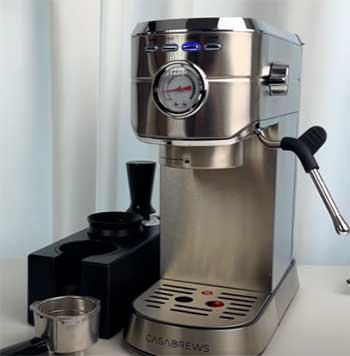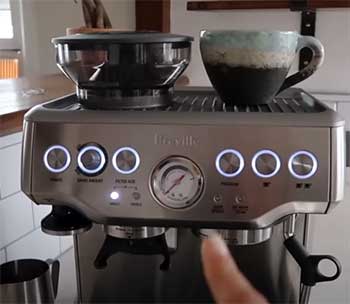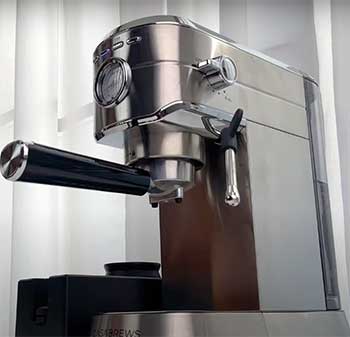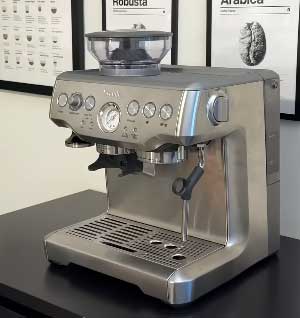I’ve been on a quest for the perfect home espresso for what feels like an eternity. It’s a journey that’s led me down countless rabbit holes of online reviews and video comparisons.
Finally, I got my hands on two of the most talked-about machines in the entry-level to mid-range market: the Casabrews CM5418 and the iconic Breville Barista Express.
My goal here is simple: to walk you through my experience with both, comparing them head-to-head to help you figure out which one truly deserves a spot on your kitchen counter.
Clash of The Countertop Titans
| Feature Showdown | Casabrews CM5418 | Breville Barista Express | My Two Cents |
| The Heart (Grinder) | 15-setting conical burr grinder | Integrated conical burr grinder with 16 settings | Breville feels a tad more precise, but the Casabrews is surprisingly capable for the price. |
| Pressure Game | 20 Bar Italian ODM Pump | 9 Bar pressure with a 15 Bar Italian pump | Don’t be fooled by the higher “20 Bar” number on the Casabrews. The 9-bar extraction of the Breville is the industry standard for a reason. It’s about optimal pressure, not maximum. |
| Heating System | Advanced Thermoblock | ThermoCoil Heating System | Both heat up fast! The Breville feels a bit more stable in temperature from shot to shot, which is key for consistency. |
| User Interface | Simple buttons & pressure gauge | Intuitive dial, buttons & pressure gauge | The Breville’s layout feels more premium and gives you a greater sense of control. The Casabrews is more straightforward, almost plug-and-play. |
| Milk Frothing Wand | Commercial-style steam wand | 360-degree swivel action steam wand | Both can produce decent microfoam, but the Breville’s wand offers more control and power for latte art. The Casabrews is good for cappuccinos but less so for detailed art. |
| Build & Materials | Mostly stainless steel construction | Brushed stainless steel casing | The Breville feels like a tank. It’s heavier and more robust. The Casabrews looks the part with its stainless steel, but it’s lighter and some components feel less substantial. |
| Price Point | Budget-Friendly | Mid-Range Investment | This is the biggest differentiator. The Casabrews offers a lot for a significantly lower price. The Breville is an investment in build quality and brand reputation. |
First Impressions of Casabrews And Breville

There’s a certain magic to unboxing a new espresso machine.
It’s the promise of future mornings transformed, of café-quality coffee without leaving the house.
The arrival of both the Casabrews CM5418 and the Breville Barista Express was met with that same level of excitement, but the initial experience with each was distinctly different.
The Breville Barista Express arrived in a box that felt substantial, heavy.
Lifting it out, the machine had a reassuring heft. The brushed stainless steel was cool to the touch, and every component, from the portafilter to the tamper, felt solid and thoughtfully designed.
It immediately gave off an aura of quality and durability. It’s the kind of appliance that you feel has been engineered, not just assembled. The included accessories were a nice touch – a high-quality tamper, a milk jug, and different filter baskets. It felt like a complete starter kit.
Then came the Casabrews CM5418. The box was lighter, and so was the machine itself. While it boasts a stainless steel construction, and it does look sleek from a distance, you can tell where some costs were cut.
Some of the components felt more plasticky, and the overall build, while perfectly adequate, didn’t have that same tank-like feel of the Breville. The portafilter, for instance, felt a bit less substantial in my hand.
However, for its price point, I was still impressed. It looked like a serious machine, and it came with everything I needed to get started. The initial impression was one of value – it looked like it cost more than it did.
Setting them up on my counter, the size difference was noticeable. The Breville has a larger footprint, taking up a significant chunk of real estate. The Casabrews is a bit more compact, making it a potentially better option for smaller kitchens.
Both have a similar aesthetic, with the stainless steel finish and the prominent pressure gauge, but the Breville’s design just feels a bit more refined, a little more timeless.
The Daily Grind: A Tale of Casabrews And Breville

The integrated grinder is one of the main draws for both of these machines.
It simplifies the espresso-making process and saves you from having to buy a separate, often expensive, piece of equipment.
But as I quickly discovered, not all integrated grinders are created equal.
The Breville Barista Express features a conical burr grinder with 16 settings. What I appreciate most about it is the level of control it offers. The grind size dial is located on the side of the machine, and it’s easy to make small, incremental adjustments.
This is crucial when you’re “dialing in” a new bag of beans – that meticulous process of finding the perfect grind size to achieve the ideal extraction time. The Breville’s grinder feels consistent, and once I found the sweet spot for my beans, I could rely on it to deliver a similar result every time.
The grind-on-demand feature, where you push the portafilter into a cradle to activate the grinder, is incredibly convenient and helps minimize waste.
The Casabrews CM5418, on the other hand, comes with a 15-setting conical burr grinder. While it has one less setting on paper, it still offers a decent range for dialing in your shots. The adjustment mechanism is a rotating collar at the base of the bean hopper. It works well enough, but it doesn’t feel as precise as the dial on the Breville.
I found that the jumps between settings were a bit larger, which sometimes made it tricky to hit that perfect in-between grind size. It’s a capable grinder, especially for someone new to home espresso, but it lacks the fine-tuned control that a more experienced user might crave.
The grinder on the Casabrews is also noticeably louder than the one on the Breville, which might be a consideration for early risers with sleeping family members.
In terms of performance, both grinders produce a suitable grind for espresso. The Breville, however, seems to produce a slightly more uniform grind with fewer fines, which contributes to a more balanced and consistent extraction.
With the Casabrews, I occasionally had to deal with a bit more channeling in my puck, which is when water finds a path of least resistance and results in an uneven extraction. It’s not a deal-breaker, but it’s a small difference that highlights the refinement of the Breville’s design.
The Moment of Truth: Pulling The Perfect Shot
This is where the magic happens. The process of tamping the grounds, locking in the portafilter, and watching that rich, syrupy espresso flow into the cup is a daily ritual for me. Both machines are capable of producing excellent espresso, but they get there in slightly different ways, and the experience of using them differs significantly.

The Breville Barista Express operates on the principle of low-pressure pre-infusion followed by a 9-bar extraction.
This is the gold standard in the world of espresso.
The pre-infusion gently soaks the coffee puck, allowing it to expand and settle before the full pressure is applied.
This helps to prevent channeling and ensures a more even extraction.
The pressure gauge on the front of the machine is not just for show; it gives you real-time feedback on your extraction pressure. This is an invaluable tool for learning and improving your technique. If the pressure is too low, your grind is too coarse; if it’s too high, your grind is too fine.
It’s like having a little espresso coach built into your machine. The ThermoCoil heating system ensures that the water is at the optimal temperature for extraction, and I found the temperature to be remarkably stable from shot to shot. The result is consistently delicious espresso with a rich crema and a well-balanced flavor profile.
The Casabrews CM5418 boasts a 20-bar Italian ODM pump. Now, in the world of marketing, bigger numbers often sound better. But when it comes to espresso, more pressure isn’t necessarily a good thing. The industry standard of 9 bars is considered optimal for a reason. Excessive pressure can lead to over-extraction, resulting in a bitter and astringent shot.
While the Casabrews has a pressure gauge, I found it to be less responsive and informative than the one on the Breville. It often shoots up to the higher end of the scale, regardless of my grind size. The machine also features a pre-infusion function, which is a great inclusion at this price point.
However, I found it harder to achieve the same level of consistency with the Casabrews as I did with the Breville. Some shots were fantastic, while others were a bit underwhelming. The thermoblock heating system gets the machine up to temperature quickly, but I did notice some temperature fluctuations, which can impact the taste of the espresso.
When it comes to the actual usability, the Breville feels more tactile and engaging. The portafilter locks into place with a satisfying clunk, and the buttons have a solid, responsive feel. The Casabrews is a bit more utilitarian. The buttons work perfectly fine, but they lack that premium feel.
The portafilter is lighter and doesn’t feel as robust. These are small details, but they add up and contribute to the overall user experience.
The Art of Milk: Steaming and Frothing

For many, an espresso machine is not just for straight shots; it’s a gateway to a world of milk-based drinks like lattes, cappuccinos, and flat whites.
The quality of the steam wand is therefore a critical factor.
The Breville Barista Express features a commercial-style steam wand that swivels 360 degrees.
This makes it incredibly easy to position your milk jug at the perfect angle.
The steam wand has a single-hole tip, which gives you a lot of control over the texturing process.
With a bit of practice, I was able to consistently produce silky-smooth microfoam, the kind you need for creating latte art. The steam power is impressive for a home machine, and it allows you to steam milk quickly and efficiently. There’s a definite technique to it, but the machine provides you with the tools you need to master it.
The Casabrews CM5418 also comes with a commercial-style steam wand. It’s a huge step up from the panarello-style wands often found on cheaper machines. It can certainly produce decent foam, especially for cappuccinos where you want a thicker, more voluminous texture.
However, I found it more challenging to create the fine, velvety microfoam required for latte art. The steam power feels a bit less potent than the Breville’s, and it takes a little longer to steam the milk to the desired temperature.
The wand’s movement is also a bit more restricted than the 360-degree swivel of the Breville. It’s a perfectly capable steam wand for everyday use, but if you’re a budding latte artist, the Breville has a clear advantage.
Pros And Cons of Casabrews And Breville
After spending considerable time with both machines, I’ve come to appreciate their individual strengths and weaknesses. Here’s a more detailed breakdown.
The Breville Barista Express: The Pros

- Exceptional Build Quality: From the moment you unbox it, the Breville exudes quality. The brushed stainless steel body, the heavy-duty portafilter, and the solid feel of the buttons and dials all contribute to a premium experience. This is a machine that feels like it’s built to last.
- Integrated High-Quality Grinder: The conical burr grinder is a standout feature. It offers a good range of adjustments and delivers a consistent grind, which is fundamental to making good espresso. The grind-on-demand function is a game-changer for convenience and freshness.
- Precise Extraction Control: The combination of low-pressure pre-infusion, 9-bar extraction pressure, and the informative pressure gauge gives you an incredible amount of control over the brewing process. It’s a machine that grows with you as your skills develop.
- Powerful Steam Wand: The 360-degree swivel steam wand is powerful and capable of producing excellent microfoam for latte art. It puts you in the driver’s seat when it comes to texturing milk.
- Thoughtful Design and Accessories: Little things like the “Empty Me!” indicator for the drip tray, the hidden storage compartment for accessories, and the included high-quality tamper show that Breville has really thought about the user experience.
The Breville Barista Express: The Cons
- The Price Tag: There’s no getting around it – the Breville Barista Express is a significant investment. It’s one of the more expensive machines in the entry-level to mid-range category.
- Larger Footprint: This is not a small machine. If you have limited counter space, you’ll need to measure carefully to make sure it fits.
- Potential for Maintenance: Like any high-quality appliance, the Breville requires regular cleaning and maintenance to keep it performing at its best. Descaling and cleaning the grinder are tasks you’ll need to stay on top of.
The Casabrews CM5418: The Pros
- Incredible Value for Money: This is the Casabrews’ biggest selling point. It offers a feature set that is usually found on much more expensive machines, including an integrated burr grinder and a commercial-style steam wand, all at a very accessible price.
- Compact Design: For those with smaller kitchens, the more compact footprint of the Casabrews is a definite advantage.
- User-Friendly for Beginners: The straightforward interface and simple operation make it a great choice for someone who is just starting their home espresso journey and doesn’t want to be overwhelmed by too many variables.
- Fast Heat-Up Time: The thermoblock heating system means you don’t have to wait long to pull your first shot of the day.
The Casabrews CM5418: The Cons
- Build Quality Compromises: While it looks good, the build quality doesn’t match up to the Breville. The lighter construction and use of more plastic components are noticeable.
- Less Precise Grinder: The grinder is functional, but it lacks the fine-tuned control of the Breville’s grinder. This can make dialing in your shots a bit more challenging.
- Inconsistent Extraction: The combination of the high-pressure pump and some temperature instability can lead to less consistent results in the cup.
- Less Powerful Steam Wand: While it’s a step up from basic frothers, the steam wand lacks the power and control of the Breville’s, making it harder to achieve true microfoam for latte art.
Making Your Choice
So, after all this, which machine should you choose? As I stand in my kitchen, looking at these two stainless steel contenders, the answer isn’t as simple as declaring one the definitive winner.
It really comes down to you – your budget, your expectations, and where you are on your coffee journey.
If you are just starting out, and the price of the Breville makes you weak at the knees, the Casabrews CM5418 is a fantastic option. It gives you all the essential tools you need to make genuine espresso at home without a massive financial commitment.
You’ll get an integrated grinder, a capable steam wand, and the ability to pull shots that will be miles ahead of anything from a pod machine. It’s a gateway into the hobby, and for the price, its performance is truly impressive. You are getting a machine that punches well above its weight class.
However, if you view this purchase as a long-term investment in your daily happiness, and you have a passion for coffee that you want to explore and develop, I would wholeheartedly recommend saving up for the Breville Barista Express.
Yes, it is more expensive, but you can feel where that extra money goes. It’s in the build quality that promises years of reliable service, in the precision of the grinder that allows you to chase that perfect extraction, and in the power of the steam wand that lets you hone your latte art skills.
It’s a machine that empowers you to grow. You won’t outgrow the Barista Express quickly; instead, it will be a reliable partner as you perfect your craft.
For me, the joy of the process is just as important as the final product. The tactile feel of the Breville, the feedback it provides, and the consistent results it delivers make my morning coffee ritual a more satisfying and engaging experience.
But I can’t deny the appeal of what Casabrews has accomplished – they’ve made the world of home espresso accessible to a whole new audience.
Ultimately, the choice is yours. Consider what matters most to you. Is it the thrill of getting a great deal and a machine that covers all the bases?
Or is it the satisfaction of investing in a premium tool that will reward your efforts with consistently exceptional coffee for years to come? Whichever path you choose, you’re on your way to better coffee at home, and that’s a journey worth taking.
Frequently Asked Questions (FAQ)
Yes, Casabrews is a brand that originates from China and has gained popularity for offering feature-rich espresso machines at competitive prices.
Starbucks typically uses high-end, super-automatic espresso machines from a Swiss brand called Mastrena. These are commercial-grade machines designed for high volume and consistency.
Breville machines are often more expensive due to their high-quality materials, robust construction, research and development in coffee technology, brand reputation, and comprehensive customer support.
The “best” espresso machine is subjective and depends heavily on a user’s budget, skill level, and preferences. For beginners, the Breville Barista Express is often cited as a top choice, while enthusiasts may prefer more advanced machines from brands like La Marzocco, Rocket, or Decent.
Wrapping Up
So, after living with both machines, my verdict is this: the Casabrews CM5418 is an incredible entry point, offering you the full home barista experience without breaking the bank. It’s a smart, value-packed choice.
But if you crave precision, consistency, and a machine that will grow with your passion for coffee, the Breville Barista Express is an investment in quality that pays you back with every single shot. Ultimately, you know your budget and your ambition; choose the machine that best fits your personal coffee journey.
